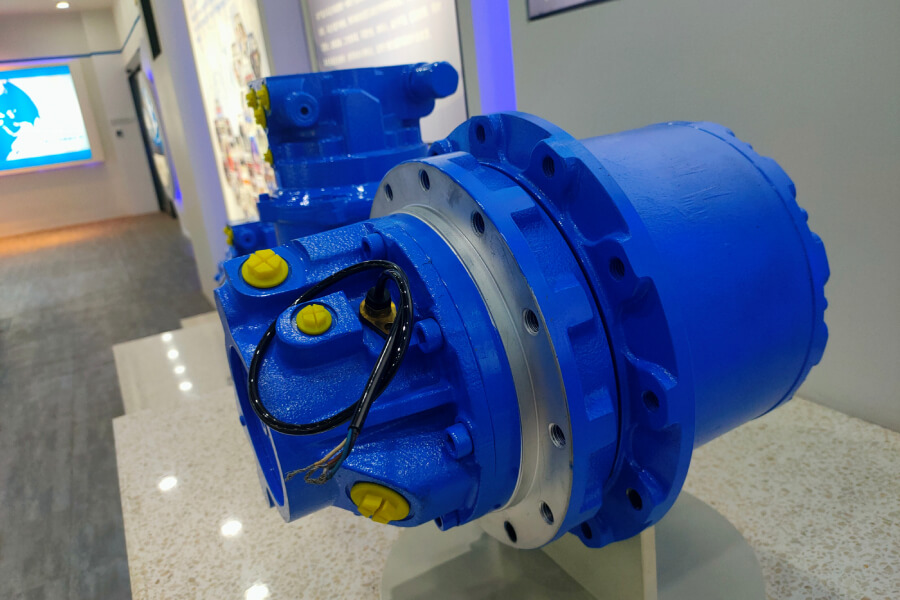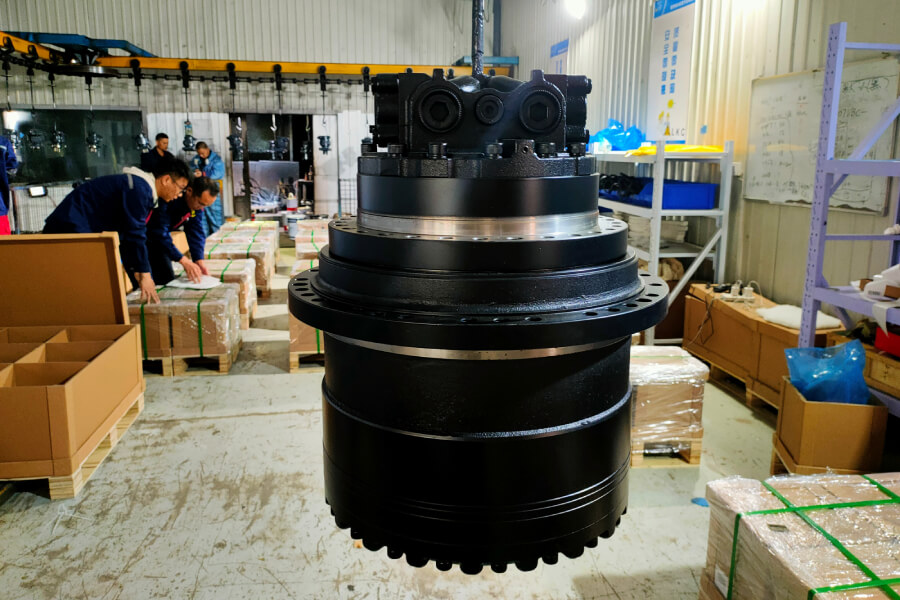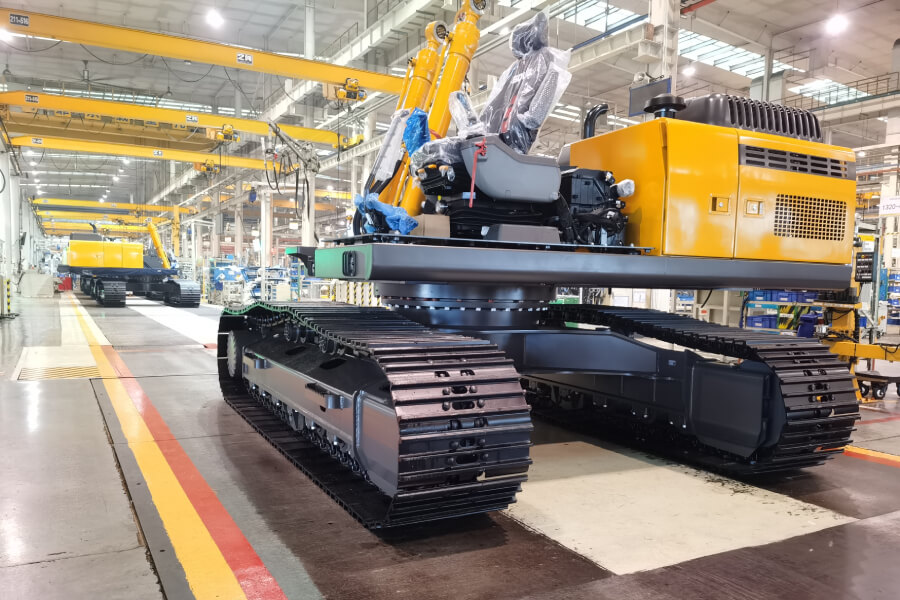A digger final drive, also known simply as a final drive, is a critical component found in heavy machinery such as excavators, diggers, bulldozers, and similar construction equipment. Its primary function is to transfer power from the engine to the tracks or wheels of the machine, allowing it to move forward, backward, or turn.
What is a digger final drive?
Components and Functionality
Motor: The final drive is powered either hydraulically or mechanically by an engine or motor. Hydraulic final drives use pressurized hydraulic fluid to generate power, while mechanical final drives use gears to transmit mechanical power.
Gearbox: Within the final drive assembly, there is a gearbox that transfers and adjusts the speed and torque of the rotational energy received from the motor. This gearbox typically contains gears that mesh together to provide the necessary speed reduction or increase depending on the application.
Drive Sprocket or Wheel Hub: The output of the gearbox is connected to either a drive sprocket (for tracked machinery) or a wheel hub (for wheeled machinery). These components transmit the rotational energy to the tracks or wheels of the machine, enabling movement over various terrains.
Bearings and Seals: Bearings support the rotating components within the final drive, ensuring smooth operation and reducing friction. Seals prevent contaminants such as dirt and water from entering the internal components, thereby protecting them from damage and extending their lifespan.
Housing: The final drive assembly is housed within a protective casing that shields the internal components from external elements and mechanical stress.
Operation
Power Transmission: The motor (either hydraulic or mechanical) generates rotational energy.
Gear Reduction: The gearbox adjusts the speed and torque of the rotational energy according to the requirements of the machine. For example, it may reduce the high-speed rotation from the motor to a slower speed suitable for driving the tracks or wheels.
Output to Drive Components: The gearbox output shaft is connected to the drive sprocket or wheel hub.
Movement: As the drive sprocket rotates (in the case of tracked machinery) or the wheel hub rotates (in the case of wheeled machinery), it applies torque to the tracks or wheels. This torque propels the machine forward or backward, or allows it to turn depending on the operator’s controls.
Importance
Power Transmission: The final drive is crucial for converting the rotational energy from the engine into the linear motion needed to propel the heavy machinery.
Durability and Performance: A well-maintained final drive ensures the durability and optimal performance of the machine, minimizing downtime and repair costs.
Versatility: Final drives are designed to operate in various conditions and terrains, providing the necessary torque and power to maneuver efficiently.
Types of Final Drives
Hydraulic vs. Mechanical: Final drives can be powered either hydraulically (common in many modern excavators) or mechanically (using gears driven directly by the engine).
Planetary vs. Inline: Planetary final drives use a set of gears arranged in a planetary configuration for compactness and high torque transmission. Inline final drives have a simpler design with gears arranged in a linear configuration.
How to Choose the right digger final drive?
Choosing the right digger final drive is crucial to ensure optimal performance, efficiency, and longevity of your heavy machinery.
Compatibility with Your Machine
Machine Specifications: Ensure the final drive matches the specifications of your excavator or digger in terms of weight class, horsepower, and hydraulic system compatibility.
Drive System: Decide between hydraulic or mechanical final drives based on your machine’s existing setup and operational requirements.
Compatibility with Future Upgrades
Future-proofing: Consider whether the final drive is compatible with potential future upgrades or modifications to your machine. This can include enhancements in performance or changes in hydraulic systems.
Performance Requirements
Torque and Speed Requirements: Evaluate the torque and speed capabilities needed for your specific applications. Consider factors such as the type of terrain you typically work on and the tasks your machine performs.
Durability and Reliability
Quality and Reputation: Choose a final drive from reputable manufacturers known for producing durable and reliable components.
Materials and Construction: Opt for final drives made from high-quality materials and with robust construction to withstand heavy-duty usage and harsh environmental conditions.
Cost Considerations
Initial Cost vs. Long-term Value: Balance the initial cost of the final drive with its long-term value and durability. A higher-quality, more durable final drive may have a higher upfront cost but can potentially save money in reduced downtime and fewer replacements over time.
Maintenance and Serviceability
Ease of Maintenance: Select a final drive that is easy to maintain and service. Look for features such as accessible service points, clear maintenance instructions, and availability of replacement parts.
Service Life: Consider the expected service life of the final drive and choose one that offers good longevity with proper maintenance.
Maintenance Tips to Keep Your Digger Final Drive in Peak Condition
Maintaining your digger final drive is crucial for ensuring smooth operation, minimizing downtime, and extending the lifespan of your heavy machinery. Here are some maintenance tips
1. Regular Inspections
Visual Inspection: Perform regular visual inspections of the final drive housing, seals, and connections for any signs of leaks, cracks, or damage.
Check for Contaminants: Inspect the area around the final drive for dirt, debris, or water ingress that could affect performance.
2. Lubrication
Follow Manufacturer Guidelines: Lubricate the final drive according to the manufacturer’s recommended schedule and using the specified lubricants.
Check Oil Levels: Regularly check the oil levels in the final drive and top up as necessary to ensure proper lubrication.
3. Cleaning
Remove Debris: Periodically clean the final drive housing and components to remove dirt, mud, and debris that can accumulate and cause wear.
Use Compressed Air: Use compressed air to blow out any dirt or debris that may have entered around seals and bearings.
4. Seals and Bearings
Inspect Seals: Check the condition of seals regularly to ensure they are intact and functioning properly to prevent contaminants from entering the final drive.
Monitor Bearings: Monitor bearings for any signs of wear, noise, or overheating. Replace bearings as recommended by the manufacturer.
5. Temperature Monitoring
Monitor Operating Temperatures: Keep track of the operating temperatures of the final drive. Abnormal temperature increases could indicate issues such as lack of lubrication or excessive friction.
6. Preventive Maintenance
Schedule Maintenance: Implement a preventive maintenance schedule for the entire machine, including the final drive, to catch potential issues early and avoid costly repairs.
Document Maintenance: Keep detailed records of maintenance activities, inspections, and any repairs performed on the final drive.
7. Operational Practices
Smooth Operation: Encourage operators to operate the machine smoothly, avoiding sudden starts and stops that can put unnecessary stress on the final drive.
Proper Loading: Ensure the machine is not overloaded, as this can strain the final drive and other components.
8. Training and Awareness
Operator Training: Train equipment operators on proper operating procedures, including the importance of maintaining the final drive and recognizing signs of potential problems.
Awareness: Foster awareness among maintenance personnel about the specific maintenance requirements and nuances of the final drive system.
Conclusion
In summary, a digger final drive is a complex yet essential component in heavy machinery, responsible for transmitting power from the engine to enable movement. Its design and functionality vary depending on the type of machine and the specific application requirements. Proper maintenance and understanding of the final drive system are critical for ensuring the longevity and efficient operation of construction equipment.
Post time: Jul-04-2024



